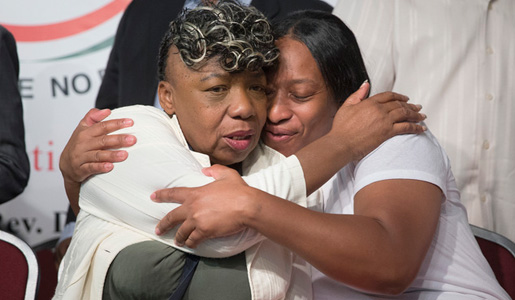
The following is an exclusive article written for the Peoples World by Gwen Carr, the mother of Eric Garner. Garner was slain by police two years ago on the streets of Staten Island for the crime of selling loose cigarettes. She writes in this article about her fears if Donald Trump is elected president of the United States.
On Friday, June 8th, I invited elected officials, community leaders, and members of the public to convene at the National Action Network’s (NAN) House of Justice in Harlem. I called for this gathering to develop a tangible plan of action to address the crisis of racialized police terror in the United States. I called for the meeting because I lost my son, Eric Garner, to racist police violence two years ago. I called for the meeting because our family, and the families of other victims, continue to fight with thousands of people behind us, yet the murders continue. We need to develop a strategy to make this movement stronger, to keep it going, and to make our demands heard.
I am especially concerned about the prospect of a man like Donald Trump becoming the president of this country. We need to be pushing forward, not merely fighting to keep things from getting worse than they already are. We will continue struggling after the elections. We will not stop until the lives of our families and communities are secure. But the conditions we struggle under will have an impact on what we are able to accomplish and how long it takes us to get where we need to be. An unapologetic racist running and ruining this nation will not help us. It will hurt us. I am working to make sure Hillary Clinton defeats Donald Trump in the election so that the people of this country can stay united and keep this movement pushing us forward. We can’t go back.
Several hundred people filled the chairs of the hall on Friday. Those in attendance lined along the sides of the crowd to take their turns speaking to the community about their assessment of the situation and what must be done to address it.
Eric Garner’s sister, Elisha, myself, and other family members of those slain by police addressed the crowd. Constance Malcolm and Frank Graham, the parents of Ramarley Graham, also spoke. The widow of Sean Bell, Nicole Paultre Bell, and other victims’ family members, were in attendance.
In turn, elected officials, leaders in the neighborhood, and leaders of local grassroots organizations and faith organizations who had been invited also spoke. Minister Kirsten Foy, President of the Brooklyn Chapter of NAN, invited leaders from specific organizations to the stage. They were brought up to give their prepared solutions in dealing with the crises. These leaders included Carmen Perez from the Justice League NYC and the Harry Belafonte-founded Gathering for Justice, Yul-san Liem of the Justice Committee and Communities United for Police Reform, New York State Assembly member Michael Blake, and Estevan Nembhard of the New York chapter of the Communist Party of the USA. Representatives were also present from organizations and movements like Raise the Wage, Cop Watch NYC, People’s Justice for Community Control and Police Accountability, National Urban League, the NAN-affiliated Young Professionals, New York Civil Liberties Union, the Working Families Party, and others.
One of the first people to speak from the general assembly was Frank Graham, whose son was shot down by police in his own home. Mr. Graham highlighted the fundamental need to develop a strategy for resistance that goes beyond marches and rallies. “It’s sad that we keep doing this over and over and over and over. Marching is good. Demonstration is good. But, for some reason, they don’t get it. We have to come up with new ideas. We have to stay focused. We can’t get mad for a week, a month, two months, or three months, and then we go back to just going to work and coming home. Those days are numbered. People are losing their lives. We’re talking about innocent people who are going about their business, or trying to make a living. In some cases, they are being killed in their own home, like my son. We have to continue with more sanctions that hurt.”
I also told the audience, “The other morning when my husband started telling me about this man in Baton Rouge and I started getting phone calls, it reminded me of Eric. This is the same thing, only they shot him. They never stop. The man in Minnesota, they killed him. In New York, in Brooklyn, I was at a protest, but they keep on killing us. What are we going to do?
“We can’t get mad for only a minute. We heard about my son’s death; we got mad. We heard about Trayvon Martin; we got mad. We heard about Michael Brown; we got mad. Now we’re hearing about these three men who died within a range of three days; now we’re mad. But what’s going to happen after two or three days and the news comes and goes away? What’s going to happen when the cameras go away? As Reverend Sharpton said, ‘Are we in a moment, or are we in a movement?’ We can’t stop because the people go away. The people are going to go away, but you have to keep aware on your own. No one else is going to do it with you. So that’s why I say, ‘I’m in for the long haul.’ This is my life, and I live this every day from now on, whatever it takes. Marching and rallying doesn’t always get it. We have got to take action. That’s why we have to band together.”
Actionable solutions presented to the public were varied and touched on a number of different areas within U.S. and New York social, political, and economic life. The need for consistency and strategy to sustain the movement was a major theme in the discussions. Connections were made between various peoples’ struggles, and the need for unity was also a thread running throughout all of the conversations that were had. Unity with the labor movement is an important note that was put forward. Calls for multi-racial, multi-gender, multi-generational, multi-issue, and international unity were also made. Discussions were had about the electoral struggle and the balance of power in the halls of city, state, and national government. The importance of mobilizing the vote locally and nationally to defeat right-wing politicians that are actively blocking progressive reforms was stressed. Concerns to build collective economic power within our communities was stated repeatedly. The large role of education and culture in the movement were acknowledged as well.
Campaigns and specific reforms were presented that are currently being fought for to make police accountable to the communities they serve and to address the economic and social crises that exist in communities of color. The Right to Know Act, The Police Statistics and Transparency Act (STAT) to present data to the public on police activity, the #Fightfor15 to eliminate poverty wages, the Raise the Age campaign to increase the age of criminal responsibility, the struggle to end gun violence, and the #March2Justice to end racial profiling, militarization of the police, and the criminalization of young people were all mentioned.
Proposals for new demands were put forward as well, such as forcing newspapers to print out complete policing data each month, imposing sanctions on precincts with horrendous records, or getting athletes and artists to withhold performances from the media to support specific campaigns. Specific tactics were discussed, including the gathering of petitions, boycotts, and the targeting of banks and corporations doing business with the Patrolmen’s Benevolent Association, the police union in New York City.
Victories won were celebrated. The #Fightfor15 has been winning partial victories in battles across the nation. Estevan of the CPUSA spoke to the audience of specific ways in which the #BlackLivesMatter movement was in a strategic position to secure these victories and push them to completion. In the fight to hold law enforcement accountable to the public, Constance Malcolm, myself, and other mothers of those killed by police had fought for an executive order for a special prosecutor of police in New York State. Just as the push for a $15 minimum wage was initially mocked, this bold demand was dismissed at first as being impossible. However, one year ago from the time of this gathering, Governor Andrew Cuomo signed the order. The need to pass a bill to establish this reform as a law was pointed out as a next stage of struggle to secure this victory as well.
Specific actions going on in the community were promoted such as The Unity March I helped organize for Saturday, July 16th. Every person in the audience was encouraged to be continually and actively engaged with the work being done. The unique roles that each person can play, and the critical value of every type of work that can be brought into the struggle was emphasized.
The #BlackLivesMatter movement is a central struggle of our time. It is our modern day Civil Rights Movement. It also has the capability of giving new urgency to the labor movement and propelling it into a radically advanced and newly progressive direction. The families of the slain, and the working families whose lives are daily at risk as a result of racial oppression and police terror, have a very special role to play in the fight.
A piece will soon follow to focus on the calls for unity that were made. More to come will elaborate upon the additional issues that were also discussed.
Stay tuned, and stay focused. We are moving forward.
Photo: Gwen Carr, mother of Eric Garner, left, and his sister Ellisha Garner, hug during a rally at the National Action Network headquarters, Saturday, July 26, 2014, in New York. | John Minchillo/AP










